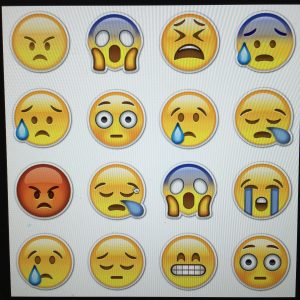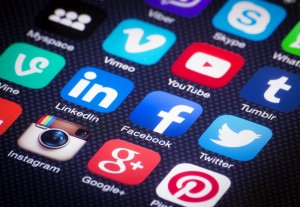
The exponential proliferation of social media sites has caused wide scale social changes over the last decade or so. The combined result of Web 2.0 coding, smart phone availability and rapid widely available mobile data networks means that we can now all participate in online social communication whenever and wherever we are.
Undoubtedly this has its advantages (or so we think, given that one in seven humans has a Facebook account) in terms of keeping in touch, self-publicising our achievements (or photos of our breakfasts) and networking with others. It also however comes with a darker side; perhaps soaking up time from more meaningful face-to-face interactions, exposing us to cyber-bullying or forcing upon us an endless stream of the selective, sanitized and overstated highlights of our “friends’” lives. (Cf Wait But Why’s excellent blog about Why Generation Y yuppies are so unhappy).
Several studies have been set up trying to answer the question of net benefit versus net cost to our mental health of these new media platforms, and so far mixed results have emerged. Adding perhaps a little more weight to this debate is the recent publication of a large survey in Depression and Anxiety by Liu yi Lin and colleagues from Pittsburgh, entitled: Association between Social Media Use and Depression Among U.S. Young Adults (Lin, 2016).
The study aimed to look at the patterns of total social media use, rather than other studies that have to date largely focused on single sites like Facebook or Twitter, to establish associations between usage and depression.
Methods
Respondents were recruited using (appropriately) a sample from an online research company. Because of the data held on respondents they were able to ensure that they gathered a highly representative sample of 3,048 young people (19-32) from across the U.S.A. who had agreed to participate in such research studies. They emailed them a depression self report scale and a set of social media use measures, and ended up with 1,787 respondents from which to calculate their dataset.
All included participants completed the Patient-reported Outcomes Measurement Information System (PROMIS) depression scale; a 4-point NIMH developed self-report scale validated against other more comprehensive scales. This was used to give three groups:
- Low (those who reported no symptoms)
- Medium (who reported sub-threshold symptoms of depression according to the APA cutoffs)
- High (whose scores correlated with symptoms consistent with a diagnosis of clinical depression).
They were also asked to give information relating to their use of social media in two ways; self reported estimates of:
- Total time per day on all social media sites for personal use
- Use of each of 11 main social media sites (ranging from “never” to “5 or more times a day”.
This information was then used to calculate a third measure: a summed global frequency score. Other data was collected regarding the demographic, relationship and educational statuses of the participants.
The sample was then analysed using chi-squared tests to examine bivariable associations between the PROMIS score and other factors, and then logistic regression was used to examine the multifactorial relationships within the results.
Results
Out of 1,787 folk who completed the survey, of whom 50.3% were female and 57.5% were white, just over half were in a relationship and 38% in the high income bracket. A third had only high school qualifications, while a quarter had a bachelors degree or higher.
Interquartile range (IQR) for the median time spent on social media each day was 30-135 minutes (median 61), with only 3.2% of the sample reporting no social media site visits per week. Median number of social media visits a week was 30 (IQR 9-57) and global score median was 11 (IQR 6-17).
For the depression scores:
- A large minority (44.5%) reported no depressive symptoms (low),
- roughly another third (29.2%) scored some symptoms but not enough to be across the threshold for DSM depression (medium),
- while around another quarter (26.3%) did score high enough (high).
When making comparisons between two factors in the bivariable analyses the researchers found that being female, having low educational attainment and being age 27-32 correlated with higher levels of depression scores. They also found that being young, female and of low educational level correlated with more time spent per day on social media. Youngsters also visited sites more frequently per week, while young, rich and single people had higher global frequency scores.
- Multifactorial analyses showed that the highest quartile social media users (total time per day) had an odds ratio of 1.66 (95% CI 1.14 to 2.42, p=0.002) for depression compared to the lowest quartile
- Also those in the highest quartile for social media site visits per week, and global frequency scores had significantly increased odds of depression versus the lowest quartiles
- For site visits the odds ratio was 2.74 (95%CI 1.86 to 4.04, p<0.001) and for the global frequency odds were 3.05 (95% CI 2.03 to 4.59, p<0.001)
- Tellingly when the ratios for the four quartiles were graphed alongside one another, there appears to be a dose-dependent relationship between social media exposure and increasing depression scores.

This research suggests that social media use was significantly associated with increased depression.
Strengths and limitations
The researchers go on to discuss their findings of a linear relationship between social media use and depression scores from a large and generally diverse and representative sample. They note that they had a very low number in their sample who did not use social media (3.2%) and this is likely due to the recruitment method used, and speculate that this could have skewed the results as previous studies have shown higher levels of depression in those who had low social media use.
They also comment on the major limitation of their study; by being a snapshot it cannot show causation, only correlation. Correlation (as anyone who has looked at Tyler Vigen’s Spurious Correlations website will know) is a tricky beast summed up by the following: A may cause B, B may cause A, or some other factor C might cause both.
Other limitations they note include the self-reported nature of the survey in terms of both use of social media, and of depressive symptoms, and the lack of an objective “gold standard.”
They also comment that having more categories for the usage statistics might have yielded better definition of the dose dependent effects, whilst following up a sample cohort over time would shed better light on the causal relationships at play.
Discussion
In this study, Lin et al suggest that depressed individuals may use social media more due to trying to enhance their self-esteem, increased rumination, or due to these interactions being easier than face-to-face interactions when lacking energy and motivation. Conversely high levels of social media use could lead to depression due to the idealized presentations of “friends’” lives in exactly the way that the Wait But Why blog describes. It could also lead to greater potential exposure to cyberbullying, or other such attacks which impact on mood and overall wellbeing. They also draw a distinction between active and passive use of the media; passive users might be at higher risk due to feeling disconnected and more lonely.

What came first: the depression or the use of social media?
Whichever way the arrow of causation points, the authors suggest that the increasing use and pervasive creep of social media into peoples’ lives means that clinicians should be asking about internet habits as part of their assessments. Additionally, it would appear that there is an onus for social media websites to look at ways of helping their users who appear to be showing signs of depression online (or other mental illnesses one might suppose). Some websites (e.g. Facebook in Australia) are already doing so by offering support when certain words are used in posts, or by allowing others to flag concerns about someone’s mental health.
The researchers point to future research avenues in looking at specific site usage, examining differences between those who actively participate versus passive consumers of social media, or through assessing the differences between those posting using primarily positive versus negative emotional language.

How are you feeling today?
Conclusions
This study by Lin et al offers a look into the correlations between internet use and levels of depressive symptoms in a large sample population. Higher levels of depression were found in those using social media most often in an apparent dose dependent relationship. Causation could not be determined by this methodology, but follow up studies could explore this. Clinicians should be alert to asking people (particularly young people) about their use of social media, and work with such websites to develop tools that can direct users to appropriate mental health information and support if they are posting content that suggests their mental health is declining.
Links
Primary paper
Lin LY, Sidani JE, Shensa A, Radovic A, Miller E, Colditz JB, Hoffman BL, Giles LM, Primack BA. (2016) Association between social media use and depression among US young adults. Depress. Anxiety, 33: 323–331. doi: 10.1002/da.22466 [Abstract]
Other references
Wait But Why? (2013) Why Generation Y Yuppies Are Unhappy.



Socially Moodier? High social media use may increase depression https://t.co/aMNJ2v4s2s #MentalHealth https://t.co/FzA3aH6Qdc
Have a look at my new @Mental_Elf blog: Socially Moodier? https://t.co/1pZQpKXhlG
Today @egosyntonically on assoc btwn social media use & depression in young US adults https://t.co/IPtPg19L3Z #SoMe #Depression
Does social media make you socially moodier?
New study links social media & depression
https://t.co/JJYUXAX1oW https://t.co/NfFR2FC3Xh
@Mental_Elf interesting, it can have a negative effect if your friends use their accounts to boast about themselves making u feel inadequete
Socially Moodier? High social media use may increase depression https://t.co/HG24eIF8eA
Socially Moodier? High #socialmedia use may increase #depression https://t.co/gjVa8LIU01 @Mental_Elf on the #evidence from a new study
New US survey of young adults explores associations between #SocialMedia usage & #Depression https://t.co/IPtPg19L3Z
RT @Mental_Elf: Research into #SocialMedia use & #Depression should make clear distinction between active & passive use https://t.co/IPtPg1…
New study adds weight to argument that clinicians should assess patients’ social media usage https://t.co/IPtPg19L3Z #depression
Don’t miss @egosyntonically Socially Moodier? High social media use may increase depression https://t.co/IPtPg19L3Z #EBP
RT @Mental_Elf: Survey suggests that social media use was significantly assoc w increased depression, but causation can’t be proven https:/…
Socially Moodier? High social media use may increase depression: The Mental Elf https://t.co/CB3ILP3Dpv #hcsm
Socially Moodier? High social media use may increase depression: The Mental Elf https://t.co/CB3ILP3Dpv